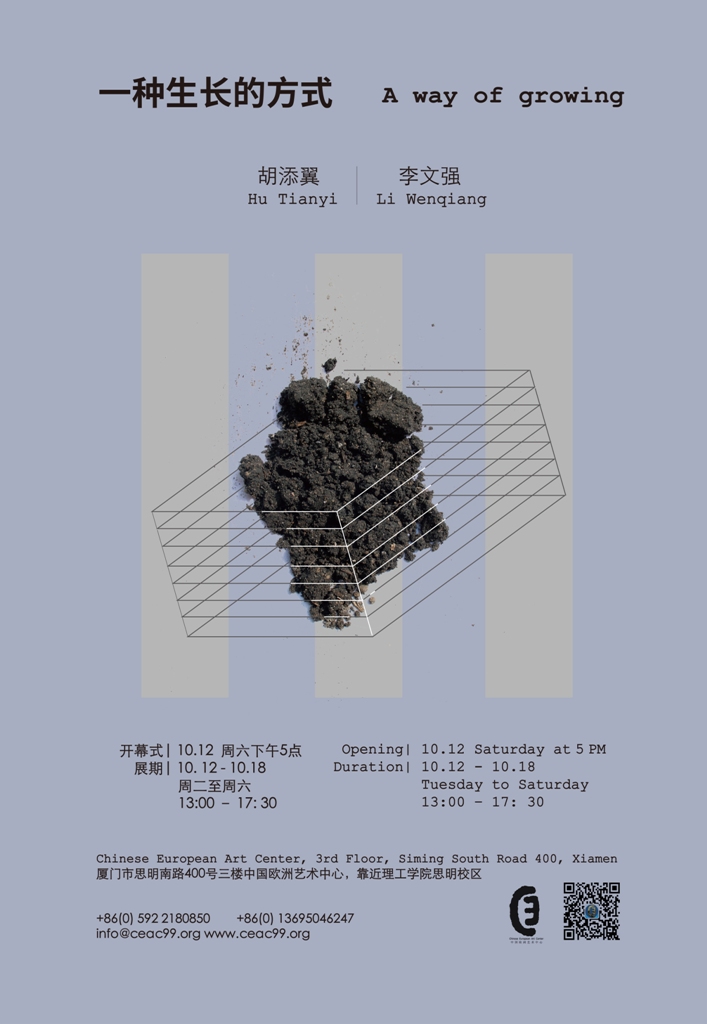Opening
October 12, 2019
Duration
October 12 till 18, 2019
Location
CEAC, Xiamen, China
 In summary
In summary
This is an exhibition of the recent works of Hu Tianyi and Li Wenqiang, focusing on life, nature and human beings. The common point of the works is to explore a way of growing. Whether the growing as metaphor is latent and creeping, or the relationship is adjusted in a material way, it is inseparable from human will and human manipulation. When we say something is growing, it may be spontaneous and natural. And when we talk about the way it grows, it means that the human subject is trying to understand the context of the situation. A driving force of life, always in alienation, mechanical, deem bodied, centralized…And so human creation is suppressed and ignored. Is the human subject driven by cognition to explore the source of his or her animality? Is there an urge to participate and change? How man confronts nature may depend on how he confronts himself.
Hu Tianyi
This series of works are derived from the mixed information, which generates a false proposition in the process of thinking: Dasein is Daisy. So I started trying to prove the false proposition. This irrational proposition gradually evolved into a more specific direction. Daisies as plants, Daisy as a subjective incarnation, Daisy as a human and Daisy as artificial intelligence.
At first I asked, what object does the term Daisy refers to when it fits the definition of Dasein? And what I found fun in the process of writing was to be free to discover the potential of the noun as a symbol, and what the meanings of the different objects it represented might be related by the same name. These different meanings serve as a window to other relevant information. I can feel that the word Daisy, as a living meaning, has become a symbiotic symbol with me.
In addition, “Dasein is Daisy” is a false statement, perhaps because it describes an object in a particular state, Daisy has a specific object, so this statement is equivalent to “a state is an object”. This expression is actually used in everyday life. For example, when we see a certain temperament that matches someone, we will say: yes, this is so Jack, and the temperament seems to be named as vivid as the person.
Li Wenqiang / Landscape Muter Slice
Urbanization has brought a highly efficient and concentrated society to human beings, and also brought many problems to life. The life of
living things in the city and its surrounding areas has been greatly affected. Death by light, road killing, window killing and construction itself are also a kind of slaughter. We give cockroaches and rats, the few creatures that are better adapted to human life, names like “four evils” and try to eliminate them.
Urban sprawl has led to alienation from the natural environment, lack of exercise, lack of common sense and emotional impetuosity. These are all symptoms of nature deficit syndrome, but it can also cause a more fatal effect, namely, the loss of people’s correct understanding of nature.
However, human beings also have curiosity about wild animals. Such feelings and repulsion and fear towards wild animals are often changed by the distance between human beings and animals.
Landscape Muter Slice hopes to present natural landscape in an isolated way in urban public space,such as science museum, zoo or park. Present the natural environment in a healthy manner, including plant, animal, fungus, and inorganic environments. And focus on the introduction and presentation of native species.
Refuse the zoo’s exotic and depressed creatures, and refuse the sale of rare species.
Refuse the dead frog or rat on the road, and the dead insect under the street lamp.
Refuse greenbelts, lawns and landscape plants.
Refuse pet birds and other pets that are treated unfairly.
Refuse cockroaches, rats, wild cats and dogs.
Refuse distorted urban ecosystems.
In an isolated world, selfishness is satisfied and life is respected.


















